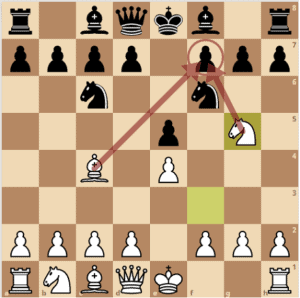Short-term combinations of moves aimed at gaining an advantage, such as winning material, delivering checkmate, or improving a position.

Introduction
Chess tactics are short-term, forced sequences of moves that can gain a material advantage, deliver checkmate, or improve position. Unlike strategy, which focuses on long-term planning, tactics involve immediate threats and combinations that can turn the game in your favor.
What are the most common tactical motifs? How have grandmasters used them in famous games? And why is mastering tactics crucial for every chess player? This guide covers the most important chess tactics, along with practical examples.
1. The Importance of Chess Tactics
Tactics are the foundation of strong play. Even the best strategic plans fail if you overlook a tactical shot. Mastering tactical patterns helps you:
- Win material (capturing pieces for free or gaining an advantage).
- Set up checkmate (forcing a win with tactical precision).
- Escape from danger (using counterattacks or defensive tactics).
- Punish mistakes (capitalizing on your opponent’s blunders).
Many of history’s greatest players, from Bobby Fischer to Garry Kasparov, have demonstrated brilliant tactical play, proving that tactics often decide games.
2. Essential Chess Tactics
2.1 The Pin
A pin occurs when an attacking piece restricts the movement of an opponent’s piece because moving it would expose a more valuable piece behind it.
Example:
- Absolute Pin: The pinned piece cannot move because the king is behind it (illegal move).
- Relative Pin: The pinned piece can legally move but would lose a more valuable piece.
✅ Example Move:
A bishop on b5 pins a knight on c6 to the king on e8.
2.2 The Fork
A fork is a move that attacks two or more pieces at the same time, often forcing the opponent to lose material.
Example:
- A knight on d4 can fork a king on e6 and a rook on c6, forcing a material win.
✅ Example Move:
- Nd4+ (forks the king and rook)
- The opponent moves the king, and the knight captures the rook.
2.3 The Skewer
A skewer is similar to a pin but works in reverse: a valuable piece is attacked, and when it moves, a weaker piece behind it is captured.
✅ Example Move:
A queen on h5 attacks a rook on e8, with the king behind it. The king moves, and the queen captures the rook.
2.4 Discovered Attack
A discovered attack happens when one piece moves, uncovering an attack from another piece behind it.
✅ Example Move:
A bishop on b2 is blocked by a knight on d4. If the knight moves, the bishop suddenly attacks an opponent’s queen.
2.5 Discovered Check and Double Check
- Discovered Check: A discovered attack where the uncovered piece delivers check.
- Double Check: A move where two pieces check the king simultaneously, forcing the king to move.
✅ Example Move:
- Nd4+ (knight moves, revealing a bishop check from b2)
- The king must move, giving the attacker an advantage.
2.6 Deflection
Deflection forces an opponent’s piece to leave an important square, often exposing them to attack.
✅ Example Move:
A queen on e4 deflects an enemy rook from defending a mate threat.
2.7 Decoy
A decoy forces an opponent’s piece onto a bad square, usually leading to checkmate or material loss.
✅ Example Move:
- Qh6+ forces the black king to g8.
- White follows up with Bg7#, delivering mate.
2.8 Perpetual Check
A perpetual check is a drawing tactic where one player continuously checks the opponent’s king, preventing escape.
✅ Example Move:
- Qg5+ (king moves)
- Qh5+ (king moves back)
- The game is drawn because of repeated checks.
2.9 Zwischenzug (Intermediate Move)
A zwischenzug, or intermezzo, is an unexpected intermediate move that disrupts an opponent’s plan.
✅ Example Move:
Instead of capturing a knight immediately, White plays a check first, forcing the opponent’s king to move, before capturing the knight.
2.10 Overloading
An overloaded piece is one that is forced to defend multiple squares or pieces at once, making it vulnerable.
✅ Example Move:
If a queen is defending both a rook and a bishop, a tactical strike can force the queen to abandon one of them.
3. How Grandmasters Use Tactics
Bobby Fischer
Fischer’s games were filled with tactical precision. His ability to calculate deep tactical sequences made him one of the greatest chess players of all time.
Garry Kasparov
Kasparov’s attacking style relied heavily on tactical play. He often sacrificed material to create devastating tactical threats.
Magnus Carlsen
Carlsen is known for his strategic play, but when necessary, he can unleash brilliant tactical combinations, using forks, pins, and discovered attacks.
4. How to Improve Your Tactical Skills
Solve Chess Puzzles
Regularly practicing tactical puzzles helps you recognize common patterns.
Study Classic Games
Analyzing games from Fischer, Tal, Kasparov, and Carlsen reveals powerful tactical play.
Play Online Blitz Games
Fast games force you to think quickly, improving tactical pattern recognition.
Use Chess Engines and Analysis Tools
Tools like Stockfish, Lichess, and Chess.com’s Puzzle Trainer help train tactical awareness.
5. Conclusion
Tactics are the heart of chess, shaping the outcome of many games. By mastering forks, pins, skewers, and other tactical motifs, players can significantly improve their strength over the board. Whether attacking, defending, or counterattacking, tactical awareness is a skill that separates good players from great ones.
Practicing tactics daily is the best way to sharpen calculation skills, gain material advantages, and execute brilliant checkmates. Start training your tactical vision today, and you’ll see immediate improvement in your chess results.

